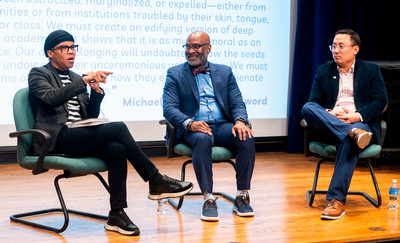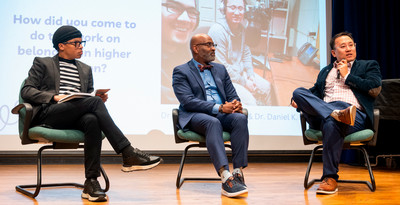Editors, Dr. Nicholas Hartlep, Dr. Terrell Strayhorn and Dr. Fred Bonner, Visit SIUE to Share Stories from their New Book, “Belonging in Higher Education”
Book Features Experiences from Diverse Faculty; Foreword by Dr. Michael Eric Dyson

Presence does not constitute “belonging.” Belonging is a journey. It is part of one’s narrative, and in building the conditions of belonging, it starts with honoring people’s story, according to Terrell L. Strayhorn, PhD, one of the three editors of “Belonging in Higher Education: Perspectives and Lessons from Diverse Faculty.”
Southern Illinois University Edwardsville’s School of Education, Health and Human Behavior (SEHHB) hosted the book editors on Tuesday, Feb. 11. Presenting their research and data in two different lectures were book editors Nicholas D. Hartlep, PhD, Robert Charles Billings Endowed Chair in Education at Berea College in Kentucky; Fred A. Bonner II, EdD, Professor and Endowed Chair in Educational Leadership and Counseling and Founding Executive Director of the Minority Achievement, Creativity and High Ability Center at Prairie View A&M University in Texas; and Strayhorn, Professor of Education and Psychology at Virginia Union University in Richmond, and Vice Provost for Faculty Development and Director of the Center for the Study of Historically Black Colleges and Universities.
 The editors were welcomed and introduced by SEHHB Dean Robin Hughes, PhD; Vice Chancellor for Student Affairs Miriam Roccia; and Assistant Vice Chancellor for Inclusive Excellence, Education and Development Lindy Wagner.
The editors were welcomed and introduced by SEHHB Dean Robin Hughes, PhD; Vice Chancellor for Student Affairs Miriam Roccia; and Assistant Vice Chancellor for Inclusive Excellence, Education and Development Lindy Wagner.
“This book creates dedicated space for the telling and retelling of the stories of professionals of color in higher education – the good, the bad and the ugly – so that we can learn from them,” said Strayhorn.
“There are vital takeaways and anyone who reads the book – college students, graduate students, staff, faculty, higher education leaders – can learn something from it,” said Hartlep. “The key takeaway is that when we increase belonging on college campuses and universities, everyone benefits from it.”
In the book, Hartlep recounts in his personal story of “unrequited love,” a negative experience that he had with a school. He admits that he was in “lust” and not in “love” with a prestigious public university who had corresponded with him for almost a year to be an “opportunity” hire. However, upon finally getting to the campus, Hartlep learned and felt that he was not truly wanted there. A little while later, he got an email from an administrator saying that the school would not be offering Hartlep a position.
 “I am happily employed at a radical liberal arts college and am an endowed chair, one of the very few Asian/American education scholars who hold such a title,” wrote Hartlep. “I am valued. I do feel as if I belong at Berea College, and I feel as though I matter.”
“I am happily employed at a radical liberal arts college and am an endowed chair, one of the very few Asian/American education scholars who hold such a title,” wrote Hartlep. “I am valued. I do feel as if I belong at Berea College, and I feel as though I matter.”
Bonner also shared some of his experiences in higher education. He has had a history dating back to 1997 of working with minoritized populations and making sense of their experiences in macro population settings in education.
“I wanted to tell a counter narrative,” shared Bonner. “Because the narrative at the time for my population of African American males in college was the case of the ‘nots.’ They are not successful. They are not achieving.”
However, Bonner looked at groups of “young, gifted and Black males.” One question he asked them was what made them choose to attend either a predominantly white college (PWI) or a Historically Black College and University (HBCU). He also considered their experiences once they arrived at their selected schools.
“This was my trajectory of what it meant to belong,” said Bonner, who said for himself he found five major themes of being in higher education as a Black man.
“Proving Yourself Over and Over,” he wrote in the book’s preface under his section, “Fred’s Prelude and Fugue: Belonging in the HBCU and PWI Context.” “Providing the Entertainment, Being Kept Out of the Loop, Playing Two Roles and Feeling Unwelcome. Here almost two decades later, from my current positionality as a Center Director and Endowed Chair, it is gut-wrenching for me to say, ‘The more things change, the more they stay the same.’ As I look at each of the five themes, it is readily apparent that at their core is a need for agency, a need for a sense of belonging.”
The book also contains chapters of belonging experiences from a range of BIPOC (Black, Indigenous and People of Color) Americans. The book’s foreword, “Deep Belonging,” is written by Michael Eric Dyson, PhD, academic, author, ordained minister and radio host.
“Deep belonging shields its members from, or prepares them to adequately confront, hostile settings and destructive forces,” wrote Dyson. “… Our very presence often provokes unease in some of our colleagues. Our bodies upset perceptions of what scholars should look like, what kind of hair scientists should grow, what kind of dress should adorn the limbs of researchers … At best, our bodies are redeemed in the freedom and imagination that thrive where we most deeply belong.”
Photos:
Editors of the book, “Belonging in Higher Education: Perspectives and Lessons from Diverse Faculty,” visited SIUE. Shown left to right: Terrell L. Strayhorn, PhD; Fred A. Bonner II, EdD; and Nicholas D. Hartlep, PhD.









